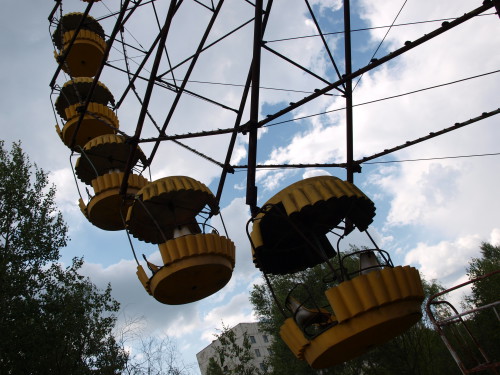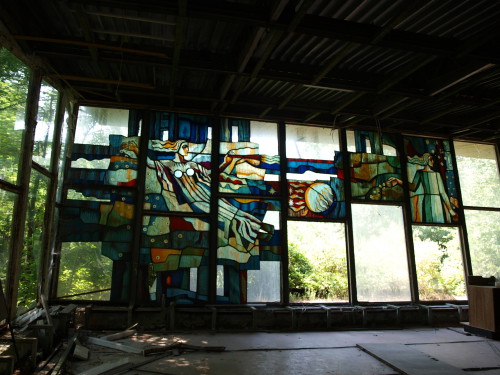I’ve been writing and designing a tabletop roleplaying game called Chernobyl mon amour for some years now. I started soon after visiting the Chernobyl Zone of Alienation myself in 2010. It’s taken a lot of time to consider some of the ideas in the game, and a core reason for this is that I’m trying to reflect the play culture I’ve marinated in for the last 25 years.
The game will be about love and radioactivity. I hope to have it published late this year or early next year, first in Finnish and then in English.
I have the feeling that none of the established, published roleplaying design philosophies really do what I want them to do, so to be able to write the game, I have to learn to express things that have grown organically in our local game culture. This is not simple.

Originally, Chernobyl mon amour (or Tšernobyl, rakastettuni in Finnish) was going to be more conventional, but the more I thought about it, the more I felt that to be understood, it would have to contain some pretty elementary stuff. Things about our culture that are obvious to me, but not to roleplayers who haven’t played in these games.
(Please note that the “we” and the “our” in this text refer to the narrow and specific environment in which I normally play tabletop games in Helsinki, Finland.)
With this in mind, here are some principles I’ve been thinking about:
Character immersion. This is at the core of what we do. You immerse emotionally into your character. You experience the game through this character. You experience happiness, sadness, love and anger through your character. You may take metagame factors into account as you play, but emotionally you’re in there, immersed in the character’s perspective.
Life, not story. The goal of the game is to create a lived experience. Things happen to your character the same way they happen to you, except more condensed and probably more exciting. The players are not making a story, they’re experiencing things through their characters. Stories are made of what happened in the game, the same way stories are made from what happens in real life. Stories are the residue of game and life both.
Fiction, yet real. A roleplaying game is obviously fiction. I’m not my character and the events of the game don’t really happen. We’re just a bunch of folks in a room, talking. Yet looking at it from a different perespective, they do happen. They are real. When I play through a date, I have experienced a date, even if it was a fictional date. I have really experienced a fictional experience. Game events are fictional things that happen to me, through the character.

These principles have implications that further shape the way the game is played and created:
The idea of creating a lived experience works best if the metagame aspects of the game are mostly kept in the hands of a game master. I’m not a puritan: Some game mechanical stuff might be fun, and sometimes the players can appropriate some game master control.
Long campaigns running for ten, twenty, fifty or a hundred games work better than short stuff, because life is meandering and there needs to be space for improvisation. The structure cannot be ironclad.
Both the principles of immersion and being real mean that social stuff works very, very well as game content. High-resolution social encounters are some of the most satisfying and fun things to play within this framework.
Other principles might be:
Privacy is freedom. These games are tailored for the specific people who play in them. We are responsible for the people who are in the room, and create things for each other. The fact that a tabletop game is private means that we can create with a freedom that’s impossible in the context collapse -rich environment of the internet or any publicly released media.
Difficulty is strength. While my experience has been that everyone can learn to play like this, good, committed and motivated players are what really makes a game sing. The game demands a lot from the game master. She doesn’t just run the game; she has to be an auteur. She needs a vision.

So far, trying to write a game book according to this kind of thinking has been all about analyzing what we do when we play. I’ve tried to codify ideas ranging from how games are constructed to what we eat. The last time I seriously tried this was in my 2005 book Roolipelimanifesti. It’s a guidebook about how to run roleplaying games, and includes a scenario or a game of sorts called Joutomaa (Wasteland).
Please note that this kind of roleplaying is agnostic when it comes to genre or style. I’ve run and played in very different kinds of games that together formed this set of ideas, from superheroes to kitchen sink realism. One obvious feature of most of these games has been the use of extremely light or non-existent game mechanics, because rules systems in the style of D&D, Vampire: the Masquerade or Apocalypse World distract from the immediacy of the game. Perhaps that’s another principle: The system must be invisible.
We’ll see how this works when trying to express a specific design instead of general guidelines. I will also update and refine the ideas presented in this post and probably publish something less tentative once my thinking has been clarified by discussion.
One thought on “Non-Digital: Expressing Play Culture (Also: Chernobyl)”
Comments are closed.